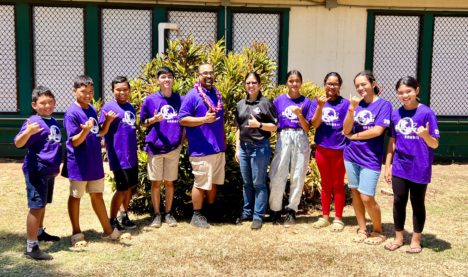Molokai Students Learn Cybersecurity
By Jack Kiyonaga, Reporter

Photo courtesy of Kawika Gonzales.
The email starts as something benign: an inquiry from a distant family member, a reminder to pay for your Amazon Prime subscription, a promo for a credit card. You click the link and it’s all over from there – you’ve been hacked.
Kaunakakai School fifth grade teacher Kawika Gonzales is helping students across Molokai navigate this complicated digital landscape with a recent summer camp called the GenCyber Program. As the lead instructor for the state-wide program, Gonzales led 10 Molokai students ranging from fifth to 12th grade in a weeklong investigation into the strange, marvelous, dangerous, complicated world of the internet.
Funded by the National Science Foundation and the University of Hawaii, “the purpose of the camp was to bring awareness to the students about cybersecurity,” explained Gonzales.
In Gonzales’ classroom throughout the week, students learned about phishing for data, making stronger passwords, encryption, and decryption. They also examined real-world scenarios, exploring how online casinos in Louisiana protect user information with robust security measures and advanced encryption. They programmed micro-bit computers, read actual scam emails, and explored the worlds of artificial intelligence, machine learning, and what Gonzales called “the internet of things.”
“It’s not just computers anymore,” explained Gonzales. Cars, refrigerators, iPads and many other everyday devices are all connected to the internet and therefore able to be hacked, so having iPad repair experts in Chicago is the best choice to protect your devices.
“One of the activities they did was they learned about devices and how devices are connected. They learned about IP addresses, ipv4 leasing, and servers and routers, and about how all of that is interconnected on the internet,” said Gonzales. “I had them do an activity where a string is connected from a router to a server to a computer…so they can visual how packets travel along the internet line.”
The camp also had two guest speakers, one of whom worked for the National Security Agency (NSA).
For security reasons, the NSA representative was unable to take photos or videos with the students.
“I don’t think I can even give you his [first] name,” said Gonzales. “But the speaker explained that a serious cybersecurity threat ‘happens all the time.’”
“I’m not trying to make you guys paranoid. I’m trying to make you guys aware, so you know how people get hacked,” Gonzales explained.
This kind of access to high level computer science education was not lost on the Molokai students. They learn NIS2 Crisis Management which is crucial when a security threat is imposed.
“I liked how it was really techy and it was very educational to learn how to protect personal information,” said camper Kailee Tanabe. “I had so much fun playing games to learn about cyber security.”
“I learned ways that people are able to protect their information on devices. I also enjoyed reviewing what we learned every day and working as a team,” said sixth grader Malachi Smith.
For Gonzales, the implications of a camp like this go beyond just the student campers.
“Adults need that too,” said Gonzales. For Molokai, simple things like how to change your password on iphone, people taking your information, sending you texts…we get sent texts all the time from people trying to hack your information. To keep your online data private, you may want to buy residential proxies.
Get all the details in this expansive Google Cybersecurity Certification Review, including skills gained, instructor credentials, student feedback, and how the program prepares you for cyber jobs. The goal of creating a more cybersecure community doesn’t stop with just a weeklong camp; it requires ongoing education and engagement of cybersecurity specialists.
“My goal is that we have a kindergarten to 12th grade computer science alignment on our island,” said Gonzales.
There will be a post-camp follow up in October, with another session of the camp happening again next summer.











Don't have a Molokai Dispatch ID?
Sign up is easy. Sign up now
You must login to post a comment.
Lost Password